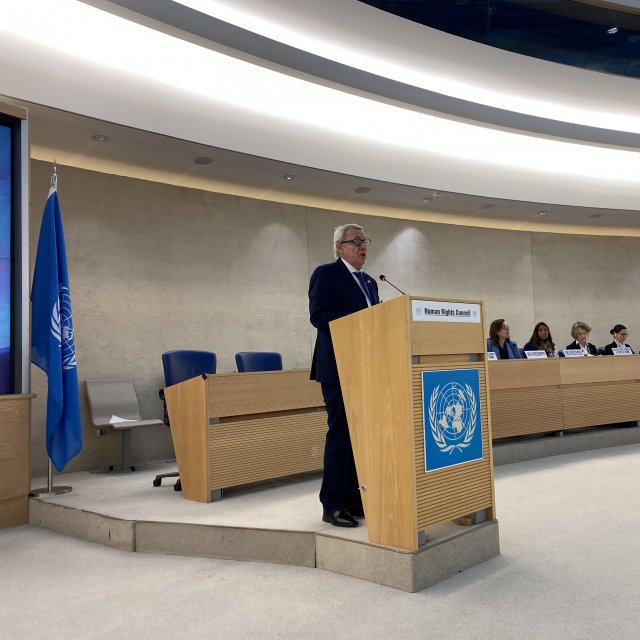 Thursday, February 27th 2025
Undersecretary meets with the Minister of Oceans and Fisheries of the Republic of Korea
Thursday, February 27th 2025
Undersecretary meets with the Minister of Oceans and Fisheries of the Republic of Korea
President Piñera announces Chile will advance a proposal to fully protect an area of the high seas in the Southestern Pacific, the first of its kind

Today, during the 2021 Virtual Leaders Climate Summit hosted on Earth Day, President Sebastian Piñera announced Chile will launch efforts to create a fully protected high seas marine protected area (MPA) in the Eastern Pacific as a priority measure to address the climate crisis. The high seas MPA will be the first of its kind, protecting the Nazca Ridge, an area incredibly rich in biodiversity and abundant in endemic species. The Nazca Ridge includes a series of connected submarine mountains offering refuge to both resident and migratory marine species, including threatened blue whales and leatherback sea turtles that return to these waters annually to breed and feed. The area proposed for protection has been designated as an Ecologically and Biologically Significant Area (EBSA) in need of protection under the United Nations Convention on Biological Diversity (CBD).
The high seas MPA will link up existing protections by connecting the fully protected Nazca-Desventuradas Archipelago MPA to the east and the highly and fully protected areas of Rapa Nui and Motu Motiro Hiva MPA to the west, both within Chile’s adjacent national waters.
This announcement followed a call by President Piñera to urgently protect the waters around the Antarctic Peninsula, another high-level ocean priority currently championed by the Chilean government.
Chile has long maintained the need to safeguard the ocean and advance marine protected areas as a key measure to address the climate crisis, including during its tenure as President of the UN Framework Convention on Climate Change COP25. During his speech, President Piñera highlighted:
"We have dubbed COP25 as "the Blue COP" precisely to underscore the role that the Ocean plays as a climate regulator agent and the importance of protecting it. Chile has already established marine protected areas that cover over 43% of our EEZ, but it’s not enough, and that’s why today I want to invite you to go further by asking you to join Chile in [these] two concrete proposals."
Chile wants to go further by starting what it calls "the second phase" of its efforts to secure marine protected areas. The Nazca Ridge fully protected high seas MPA proposal will be developed by a high-level scientific-technical group and will be presented to relevant international organizations with the objective of protecting the area from destructive extractive activities and compounding threats that currently affect its marine ecosystem; conserving biodiversity and ensuring the ocean's continued role as a carbon sink. While the South Pacific Regional Fisheries Management Organization (SP-RFMO) will be engaged in the process, the new UN high seas treaty, currently under negotiation, is meant to be the international body that will oversee the long-term management of the MPA to ensure science-based, precautionary conservation measures are in place to protect all biodiversity of the area.
World-renowned oceanographer and marine scientist Dr. Sylvia Earle celebrated the announcement:
"Protecting the ocean is essential to addressing climate change and biodiversity loss, two key issues that threaten planetary security and human prosperity. Full protection is urgently needed for the Nazca Ridge and its backbone of undersea mountains which are globally recognized as a biodiversity hot spot. Chile’s leadership has set a high bar among nations for ocean stewardship, and that leadership is needed now as never before to bring about enduring care for the Nazca Ridge, an important link in the living ocean system that makes Earth a planet habitable for humans."
Chile is firmly committed to realizing a network of highly and fully protected high seas MPAs around the world as a means to conserve marine biodiversity and build resilience to a changing climate.
This new high seas MPA is a groundbreaking first step and builds on Chile’s efforts through the Blue Leaders initiative, the Global Ocean Alliance, the High Ambition Coalition for People and Nature, and others, to secure a new global ocean protection target at the upcoming Convention on Biological Diversity (CBD) COP to protect at least 30% of the ocean by 2030 through a network of highly and fully protected MPAs.
Related articles
 Thursday, February 27th 2025
Undersecretary meets with the Minister of Oceans and Fisheries of the Republic of Korea
Thursday, February 27th 2025
Undersecretary meets with the Minister of Oceans and Fisheries of the Republic of Korea
 Monday, February 24th 2025
Minister van Klaveren reaffirms Chile's commitment to human rights and gender equality
Monday, February 24th 2025
Minister van Klaveren reaffirms Chile's commitment to human rights and gender equality









